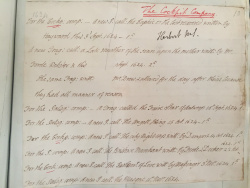Fair Star of Antwerp: Difference between revisions
m (Text replacement - "\[\[(i|I)mage:(.+)\|link=https?:\/\/(www\.)?lostplays.org\/images\/[\a-zA-Z0-9]+\/[\a-zA-Z0-9]+\/(.+)\]\]" to "<!--newThumb-->250px<!--/newThumb-->") |
MeaghanBrown (talk | contribs) mNo edit summary |
||
| Line 10: | Line 10: | ||
<br> | <br> | ||
:(Folger Shakespeare Library, MS W.b.156 ("Fortune"), p149. Reproduce by permission of the Folger Shakespeare Library; see also Bawcutt, entry 121, p.156) | :(Folger Shakespeare Library, MS W.b.156 ("Fortune"), p149. Reproduce by permission of the Folger Shakespeare Library; see also Bawcutt, entry 121, p.156) | ||
<br> | <br> | ||
<br>[[category:Folger]][[category:Halliwell-Phillips]] | <br>[[category:Folger]][[category:Halliwell-Phillips]] | ||
| Line 17: | Line 17: | ||
Palsgrave's Company at the Fortune | Palsgrave's Company at the Fortune | ||
<br> | <br> | ||
<br> | <br> | ||
| Line 23: | Line 23: | ||
Tragedy; devil play? | Tragedy; devil play? | ||
<br> | <br> | ||
<br> | <br> | ||
| Line 29: | Line 29: | ||
See "For what it's worth" | See "For what it's worth" | ||
<br> | <br> | ||
<br> | <br> | ||
| Line 35: | Line 35: | ||
None known | None known | ||
<br> | <br> | ||
<br> | <br> | ||
Revision as of 08:55, 27 August 2018
Historical Records
Dramatic Records of Sir Henry Herbert
J. O. Halliwell-Phillips transcribed a number of Sir Henry Herbert's licensing records and compiled them in various scrapbooks now held at the Folger Shakespeare Library. Amongst them is the following transcription of plays from September 1624, which includes:
For the Palsg: Comp: - A Trag: called the Faire Star of Antwerp 15th Sept. 1624 1 li.
- (Folger Shakespeare Library, MS W.b.156 ("Fortune"), p149. Reproduce by permission of the Folger Shakespeare Library; see also Bawcutt, entry 121, p.156)
Theatrical Provenance
Palsgrave's Company at the Fortune
Probable Genre(s)
Tragedy; devil play?
Possible Narrative and Dramatic Sources or Analogues
See "For what it's worth"
References to the Play
None known
Critical Commentary
This is one of a group of at least fifteen new plays licensed by Herbert between July 1623 and November 1624 for the Palsgrave’s Company, formerly the Admiral's Men. In 1621, their theatre, the Fortune, had burnt down, and three years later they were still attempting to recover from the destruction not merely of their venue but also, it is thought, of their stock of playbooks. This concentration of new writing for one company, fifteen plays in little over a year, is unparalleled in Herbert's records. Fourteen of the fifteen are lost, the survivor being Thomas Drew's The Duchess of Suffolk. As far as one can tell, the post-fire licensings represented an attempt to rebuild a working repertory. (See Gurr, Shakespeare's Opposites, 47; Bentley, 1.149; Bentley, 5.1327-8)
Another member of the group, Jugurtha, seems to have been a reworking of an old Admiral's Men play from around 1600: see the LPD entry on Jugurtha, King of Numidia.
In its own right, the lost The Fair Star of Antwerp has been very little discussed. Paulina Kewes mentions the play, noting that it was licensed two months after news of the the Amboyna massacre reached England. Its title, suggests Kewes, implies engagement with the Dutch wars: it may have "reverted to the old model of representing Spanish-Dutch (and English-Dutch) relations", in contrast to the anti-Dutch feeling consequent upon the massacre (288).
For What It's Worth
EEBO-TCP searches currently shed no obvious light on the phrase "fair star of Antwerp".
Work by other scholars on other LPD plays gives a clue that might yield new progress on this one with a connection not, I believe, hitherto suggested. That suggestion is: The title indicates that the play may have dramatized the story of the Proud Woman of Antwerp, who blasphemes while trying to get her ruff arranged correctly, and is visited and ultimately murdered by the devil in the disguise of a handsome young man.
For the story, related at length by Philip Stubbes, see the LPD entry on Friar Rush and the Proud Woman of Antwerp, a lost play acted by the Admiral's Men in 1602. Basically, the Proud Woman story is a tragic one; about a beautiful woman; set in Antwerp. It thus fits with the title and known genre of The Fair Star of Antwerp. Additionally, Friar Rush and the Proud Woman of Antwerp shows that the Proud Woman story is one which had already been found suitable for dramatization on the English professional stage, and which enjoyed some success, given the later references to it already known and collected in the LPD entry for Friar Rush.
If the suggestion made above is tenable, then we can say a little more about the genre of The Fair Star of Antwerp, which would, for instance, necessarily have featured a devil to corrupt and murder the heroine. It would have been a devil play. Additionally, the Proud Woman connection would make The Fair Star of Antwerp, like its Palsgrave's Men contemporary Jugurtha, a reworking of a story which had featured in a late-Elizabethan Admiral's Men play. In reconstructing a repertory after the fire, the Palsgrave's Men were, arguably, going back to their roots.
Update, July 2016: In some ways, the 1608 German record (discussed under Friar Rush and the Proud Woman of Antwerp) is even more interesting for this play than it is for the 1602 play. "Frommen" (pious), like "Fair Star", is definitely, on the face of it, a term of praise.
Works Cited
Site created and maintained by Matthew Steggle, Sheffield Hallam University, 25 July 2011; updated 22 March 2016.
